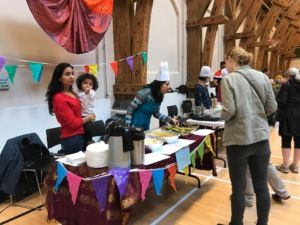Opinion
Mishra’s Mishmash: How the nature of immigration to Denmark has changed drastically
Mrutyuanjai Mishra
This article is more than 6 years old.

Community food on the menu (photo: Mrutyuanjai Mishra)
Of the thousands of internationals arriving in Denmark every year, most are primarily coming to work and study. But it hasn’t always been that way, and it’s fair to say they are changing the nature of immigration to the country drastically.
A tenth of society’s taxes
Such is the magnitude today that every tenth person receiving a salary in Denmark was born outside of Denmark and is still not a Danish citizen.
Most of the new arrivals come from eastern European countries such as Poland and Romania, according to Danmarks Statistik (DS), an organisation that keeps track of demographic changes in the country.
DS systematically and scientifically collects data, and as every salaried person is taxed, a record is maintained of how much Danish society stands to gain from this new form of immigration to the country.
Changing face of migration
Until exactly 20 years ago, new arrivals who entered Denmark as a result of marriage and family reunification accounted for almost half of the people entering the country for permanent settlement. Now the very same group constitutes a meagre fifth of the population of immigrants entering Denmark.
In 1997, the number of immigrants arriving either to work or to study composed just 32 percent of the total arrivals. Today the number of people entering and staying in Denmark to work or to study accounts for nearly double the amount: 62 percent.
In other words, the last two decades have seen a totally different pattern of immigration to Denmark. This is a result of intensive political debate regarding refugees and migrants, which started in the 1990s and has increasingly influenced the constellation of Parliament and governments since the turn of the century.
In 2004, ten new European countries were granted permission to join the European Union, and hence it became easier for people from these countries to seek work permits as members. Migration tendencies changed as political debates changed and the nature of the European Union changed.
Leaving an indelible mark
The primary source of immigration to Denmark still remains from European countries such as Poland, Romania, Germany, Spain and the UK, but the residue of political debate still centres around non-Western immigrants, who still supposedly cost the Danish state 30 billion kroner a year.
It is indisputable that the new immigrants, especially in the last two decades, have contributed substantially to the economic growth of the country. But now they are slowly and gradually also creating an interesting sub-culture, which supplements modern Danish fads and trends.
Among the new arrivals of highly-educated professionals are Indian IT experts, who are bringing with them their vegetarian food habits, which fit perfectly well into the modern trend of eating environmentally-friendly food.
For example, the Indian Regional Vegetarian Food Festival, organised by Indians in Østerbro, has attracted thousands in Copenhagen to learn about a new food concept that has remained peripheral for a long time.
Frank Jensen, the mayor of Copenhagen, wants his city to be CO2-neutral by 2025. It seems that new immigrants are merging well into this dream of eating and living in an eco-friendly way.
About
Mrutyuanjai Mishra
As a regular contributor to the Times of India, the country’s largest newspaper, Mishra is often sought-after by Danish media and academia to provide expertise on Asian-related matters, human rights issues and democratisation. He has spent half his life in India and the other half in Denmark and Sweden.










































